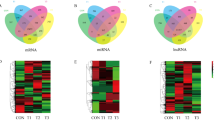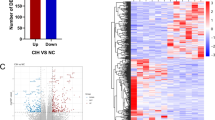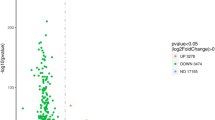Abstract
Individuals subjected to hypobaric hypoxia at high altitudes may exhibit differential physiological responses in terms of susceptibility and tolerance to the development of hypoxia-related disorders. We studied early-phase gene expression in the lungs of Sprague–Dawley rats exhibiting such differential physiological responses after exposure to acute hypobaric hypoxia for 1 h at a simulated altitude of 9144 m. RNA-seq transcriptome profiling of lung tissues revealed differential gene expression in tolerant and susceptible groups, subsequently validated by qRT-PCR for ten selected differentially expressed genes. The gene expression pattern indicated hypometabolism and negative regulation of vasoconstriction in all groups except susceptible rats, coupled with altered MAPK, p53 and JAK-STAT signaling. Upregulation of early-phase response genes including Dusp1 (dual specificity phosphatase), Cdkn1a (cyclin-dependent kinase inhibitor 1A), Txnip (thioredoxin-interacting protein), Rgs1 (regulator of G-protein signaling 1) and Rgs2 (regulator of G-protein signaling 2) in susceptible rats indicated a progression toward growth arrest and apoptosis. Enhanced expression of cell adhesion molecules, wound healing and repair bioprocesses was observed in tolerant males. Upregulated Kcnj15 (potassium inwardly rectifying channel subfamily j membrane 15) and Vsig4 (V-set and Ig domain containing 4) variants in tolerant females suggested adaptation to hypoxia possibly by fluid reabsorption to avoid edematous conditions and suppression of T cell proliferation to avoid acute lung inflammation. Our study might help in understanding the molecular–physiological mechanisms associated with progressive damage in the lung tissues of susceptible and tissue-protective measures in tolerant rats during acute hypobaric hypoxia.




Similar content being viewed by others
References
Alenzi FQB (2004) Links between apoptosis, proliferation and the cell cycle. Br J Biomed Sci 61:99–102
Bauer M, Huse K, Settmacher U, Claus RA (2008) The heme oxygenase–carbon monoxide system: regulation and role in stress response and organ failure. Intensive Care Med 34:640–648
Benjamini Y, Hochberg Y (1995) Controlling the false discovery rate: a practical and powerful approach to multiple testing. J R Stat Soc B 57:289–300
Bigham AW, Mao X, Mei R, Brutsaert T, Wilson MJ, Julian CG, Parra EJ, Akey JM, Moore LG, Shriver MD (2009) Identifying positive selection candidate loci for high-altitude adaptation in Andean populations. Hum Genomics 4:79–90
Burns AR, Smith CW, Walker DC (2003) Unique structural features that influence neutrophil emigration into the lung. Physiol Rev 83:309–336
Bustin SA, Benes V, Garson JA, Hellemans J, Huggett J, Kubista M, Mueller R, Nolan T, Pfaffl MW, Shipley GL, Vandesompele J, Wittwer CT (2009) The MIQE guidelines: minimum information for publication of quantitative real-time PCR experiments. Clin Chem 55:611–622
Fröhlich S, Boylan J, McLoughlin P (2013) Hypoxia-induced inflammation in the lung: a potential therapeutic target in acute lung injury? Am J Respir Cell Mol Biol 48:271–279
Fujino G, Noguchi T, Matsuzawa A, Yamauchi S, Saitoh M, Takeda K, Ichijo H (2007) Thioredoxin and TRAF family proteins regulate reactive oxygen species-dependent activation of ASK1 through reciprocal modulation of the N-terminal homophilic interaction of ASK1. Mol Cell Biol 27:8152–8163
Gage GJ, Kipke DR, Shain W (2012) Whole animal perfusion fixation for rodents. J Vis Exp 65:1–9
Gallagher SAand Hackett PH (2004) High-altitude illness. Emerg Med Clin North Am 22:329–355
Ghosh D, Kumar R, Pal K (2012) Individual variation in response to simulated hypoxic stress of rats. Indian J Exp Biol 50:744–748
Guntheroth WG, Kawabori I (1975) Hypoxic apnea and gasping. J Clin Invest 56:1371–1377
Guntheroth WG, Breazeale D, McGough GA (1973) The significance of pulmonary petechiae in crib death. Pediatrics 52:601–603
Gupta ML, Rao KS, Anand IS, Banerjee AK, Boparai MS (1992) Lack of smooth muscle in the small pulmonary arteries of the native Ladakhi. Is the Himalayan highlander adapted? Am Rev Respir Dis 145:1201–1204
Hahntow IN, Mairuhu G, van Valkengoed IG, Baas F, Alewijnse AE, Koopmans RP, Michel MC (2009) Are RGS2 gene polymorphisms associated with high blood pressure in an ethnicity-and gender-specific manner? Am J Hypertens 22:80–86
Hartlieb E, Kempf B, Partilla M, Vigh B, Spindler V, Waschke J (2013) Desmoglein 2 is less important than desmoglein 3 for keratinocyte cohesion. PLoS One 8:e53739
Hebenstreit D, Horejs-Hoeck J, Duschl A (2005) JAK/STAT-dependent gene regulation by cytokines. Drug News Perspect 18:243–249
Huang C, Sindic A, Hill CE, Hujer KM, Chan KW, Sassen M, Wu Z, Kurachi Y, Nielsen S, Romero MF, Miller RT (2007) Interaction of the Ca2+-sensing receptor with the inwardly rectifying potassium channels Kir41 and Kir42 results in inhibition of channel function. Am J Physiol Renal Physiol 292:F1073–F1081
Huang DW, Sherman BT, Lempicki RA (2009) Bioinformatics enrichment tools: paths toward the comprehensive functional analysis of large gene lists. Nucleic Acids Res 37:1–13
Huerta-Sánchez E, DeGiorgio M, Pagani L, Tarekegn A, Ekong R, Antao T, Cardona A, Montgomery HE, Cavalleri GL, Robbins PA, Weale ME, Bradman N, Bekele E, Kivisild T, Tyler-Smith C, Nielsen R (2013) Genetic signatures reveal high-altitude adaptation in a set of Ethiopian populations. Mol Biol Evol 30:1877–1888
Johnson JA, Johnson DA, Kraft AD, Calkins MJ, Jakel RJ, Vargas MR, Chen PC (2008) The Nrf2-ARE pathway: an indicator and modulator of oxidative stress in neurodegeneration. Ann N Y Acad Sci 1147:61–69
Kobayashi N, Hanaoka M, Droma Y, Ito M, Katsuyama Y, Kubo K, Ota M (2013) Polymorphisms of the tissue inhibitor of metalloproteinase 3 gene are associated with resistance to high-altitude pulmonary edema (HAPE) in a japanese population: a case control study using polymorphic microsatellite markers. PLoS One 8:e71993
Kolly C, Suter MM, Müller EJ (2005) Proliferation, cell cycle exit, and onset of terminal differentiation in cultured keratinocytes: pre-programmed pathways in Normal of C-Myc and Notch1 prevail over extracellular calcium signals. J Invest Dermatol 124:1014–1025
Kumar S, Sharma P, Bansal A, Sharma PC, Aggarwal KK (2014) Hypobaric hypoxia mediated protein expression in blood plasma of susceptible and tolerant Sprague Dawley rats. Indian J Med Res 140:756–765
Lee KW, Lee Y, Kim DS, Kwon HJ (2006) Direct role of NF-kB activation in Toll-like receptor-triggered HLADRA expression. Eur J Immunol 36:1254–1266
Li NF, Zhang JH, Yang J, Zhou L, Luo WL, Guo YY, Yao XG, Wang HM, Chang JH (2010) Association of genetic variations of regulator of G-protein signaling 2 with hypertension in the general Xinjiang Kazakh population. Clin Exp Hypertens 32:256–261
Lionikas A, Meharg C, Derry JMJ, Ratkevicius A, Carroll AM, Vandenbergh DJ, Blizard DA (2012) Resolving candidate genes of mouse skeletal muscle QTL via RNA-Seq and expression network analyses. BMC Genom 13:592–606
Liu F, Gore AJ, Wilson JL, Korc M (2014) DUSP1 is a novel target for enhancing pancreatic cancer cell sensitivity to gemcitabine. PLoS One 9:e84982
Lorenzo VF, Yang Y, Simonson TS, Nussenzveig R, Jorde LB, Prchal JT, Ge RL (2009) Genetic adaptation to extreme hypoxia: study of high-altitude pulmonary edema in a three-generation Han Chinese family. Blood Cells Mol Dis 43:221–225
Ma Y, Ambannavar R, Stephans J, Jeong J, Dei Rossi A, Liu ML, Friedman AJ, Londry JJ, Abramson R, Beasley EM (2014) Fusion transcript discovery in formalin-fixed paraffin-embedded human breast cancer tissues reveals a link to tumor progression. PLoS One 9:e94202
Martin B, Chadwick W, Yi T, Park SS, Lu D, Ni B, Gadkaree S, Farhang K, Becker KG, Maudsley S (2012) VENNTURE–a novel Venn diagram investigational tool for multiple pharmacological dataset analysis. PLoS One 7:e36911
Masri B, Lahlou H, Mazarguil H, Knibiehler B, Audigier Y (2002) Apelin (65–77) activates extracellular signal-regulated kinases via a PTX-sensitive G protein. Biochem Biophys Res Commun 290:539–545
Metsalu T, Viltrop T, Tiirats A, Rajashekar B, Reimann E, Kõks S, Rull K, Milani L, Acharya G, Basnet P, Vilo J, Mägi R, Metspalu A, Peters M, Haller-Kikkatalo K, Salumets A (2014) Using RNA sequencing for identifying gene imprinting and random monoallelic expression in human placenta. Epigenetics 9:1397–1409
Mortazavi A, Williams BA, McCue K, Schaeffer L, Wold B (2008) Mapping and quantifying mammalian transcriptomes by RNA-Seq. Nat Methods 5:621–628
Norton N, Sun Z, Asmann YW, Serie DJ, Necela BM, Bhagwate A, Jen J, Eckloff BW, Kalari KR, Thompson KJ (2013) Gene expression, single nucleotide variant and fusion transcript discovery in archival material from breast tumors. PLoS One 8:e81925
Papandreou I, Cairns RA, Fontana L, Lim AL, Denko NC (2006) HIF-1 mediates adaptation to hypoxia by actively downregulating mitochondrial oxygen consumption. Cell Metabol 3:187–197
Patel RK, Jain M (2012) NGS QC Toolkit: a toolkit for quality control of next generation sequencing data. PLoS One 7:e30619
Pfaffl MW, Tichopad A, Prgomet C, Neuvians TP (2004) Determination of stable housekeeping genes, differentially regulated target genes and sample integrity, BestKeeper—Excel-based tool using pair-wise correlations. Biotechnol Lett 26:509–515
Pockley AG, Calderwood SK, Multhoff G (2009) The atheroprotective properties of Hsp70: a role for Hsp70-endothelial interactions? Cell Stress Chaperones 14:545–553
Poets CF, Meny RG, Chobanian MR, Bonofiglo RE (1999) Gasping and other cardiorespiratory patterns during sudden infant deaths. Pediatr Res 45:350–354
Purushothaman J, Suryakumar G, Shukla D, Jayamurthy H, Kasiganesan H, Kumar R, Sawhney RC (2011) Modulation of hypoxia-induced pulmonary vascular leakage in rats by Seabuckthorn (Hippophae rhamnoides L.). Evid Based Complement Altern Med 2011:574524
Salim S, Dessauer CW (2004) Analysis of the interaction between RGS2 and adenylyl cyclase. Method Enzymol 390:83–99
Salojin KV, Owusu IB, Millerchip KA, Potter M, Platt KA, Oravecz T (2006) Essential role of MAPK phosphatase-1 in the negative Normal of innate immune responses. J Immunol 176:1899–1907
Samad F, Hester KD, Yang G, Hannun YA, Bielawski J (2006) Altered adipose and plasma sphingolipid metabolism in obesity: a potential mechanism for cardiovascular and metabolic risk. Diabetes 55:2579–2587
Saminathan T, Nimmakayala P, Manohar S, Malkaram S, Almeida A, Cantrell R, Tomason Y, Abburi L, Rahman MA, Vajja VG, Khachane A, Kumar B, Rajasimha HK, Levi A, Wehner T, Reddy UK (2015) Differential gene expression and alternative splicing between diploid and tetraploid watermelon. J Exp Bot 66:1369–1385
Samoilov MO, Rybnikova EA, Tulkova EI, Vataeva LA, Otellin VA, Hozhai LI, Pelto-Huikko M (2001) Hypobaric hypoxia affects rat behavior and immediate early gene expression in the brain: the corrective effect of preconditioning. Dokl Biol Sci 381:513–515
Sharma P, Kumar S, Bansal A, Nimker C, Aggarwal KK, Sharma PC (2014a) Selection of reference genes for qRT-PCR normalization to study Hif1α and Hif2α expression in hypobaric hypoxia susceptible and tolerant rats lung. Curr Trends Biotechnol Pharm 8:336–449
Sharma P, Singh DP, Kumar S, Bansal A, Aggarwal KK, Sharma PC (2014b) Acute hypobaric hypoxia induced early phase biochemical and histological changes in susceptible and tolerant rat lung tissue. Curr Trends Biotechnol Pharm 9:5–15
Shukla D, Saxena S, Purushothaman J, Shrivastava K, Singh M, Shukla S, Malhotra VK, Mustoori S, Bansal A (2011) Hypoxic preconditioning with cobalt ameliorates hypobaric hypoxia induced pulmonary edema in rat. Eur J Pharmacol 656:101–109
Spindel ON, World C, Berk BC (2012) Thioredoxin interacting protein: redox dependent and independent regulatory mechanisms. Antioxid Redox Sign 16:587–596
Tamura RE, de Vasconcellos JF, Sarkar D, Libermann TA, Fisher PB, Zerbini LF (2012) GADD45 proteins: central players in tumorigenesis. Curr Mol Med 12:634–651
Tamura K, Stecher G, Peterson D, Filipski A, Kumar S (2013) MEGA6: molecular evolutionary genetics analysis version 6.0. Mol Biol Evol 30:2725–2729
Tatemoto K, Takayama K, Zou MX, Kumaki I, Zhang W, Kumano K, Fujimiya M (2001) The novel peptide apelin lowers blood pressure via a nitric oxide-dependent mechanism. Regul Pept 99:87–92
Thompson JD, Higgins DG, Gibson TJ (1994) CLUSTALW: improving the sensitivity of progressive multiple sequence alignment through sequence weighting, position specific gap penalties, and weight matrix choice. Nucleic Acids Res 22:4673–4680
Tsai CC, Chen YJ, Yew TL, Chen LL, Wang JY, Chiu CH, Hung SC (2011) Hypoxia inhibits senescence and maintains mesenchymal stem cell properties through down-regulation of E2A-p21 by HIF-TWIST. Blood 117:459–469
Vogt L, Schmitz N, Kurrer MO, Bauer M, Hinton HI, Behnke S, Gatto D, Sebbel P, Beerli RR, Sonderegger I, Kopf M, Saudan P, Bachmann MF (2006) VSIG4, a B7 family–related protein, is a negative regulator of T cell activation. J Clin Invest 116:2817–2826
Wancket LM, Frazier WJ, Liu Y (2012) Mitogen-activated protein kinase phosphatase (MKP)-1 in immunology, physiology, and disease. Life Sci 90:237–248
Yan L, Borregaard N, Kjeldsen L, Moses MA (2001) The high molecular weight urinary matrix metalloproteinase (MMP) activity is a complex of gelatinase B/MMP-9 and neutrophil gelatinase-associated lipocalin (NGAL) modulation of MMP-9 activity by NGAL. J Biol Chem 276:37258–37265
Ye J, Coulouris G, Zaretskaya I, Cutcutache I, Rozen S, Madden T (2012) Primer-BLAST: a tool to design target-specific primers for polymerase chain reaction. BMC Bioinform 13:134
Acknowledgments
The authors express their sincere thanks to the Director, DIPAS, DRDO, for providing financial support and animal house facilities for carrying out this work. We are also thankful to Dr. Saurabh Raghuvanshi, University of South Campus, New Delhi, for providing CLC Genomics Workbench facility. Our thanks are due to Mr. Bhagwat Singh and Mr. Deependra Pratap Singh for their technical support in animal handling and tissue collection.
Conflict of interest
The authors report no conflicts of interest and are alone responsible for the content and writing of the paper.
Ethical approval
The guidelines followed for the care and use of animals including the rearing conditions and all the procedures performed were approved by the Institute’s Animal Ethical Committee, Defence Institute of Physiology and Allied Sciences, Defence Research and Development Organisation, Delhi, India, and were in compliance with all the guidelines of the Committee for the Purpose of Control and Supervision of Experiments on Animals (CPCSEA), India.
Author information
Authors and Affiliations
Corresponding author
Additional information
Communicated by S. Hohmann.
Data submission
We have deposited RNA-seq raw data and processed files of this experimental work in the GEO database repository of NCBI with series accession number GSE62688 and SRA study number SRP049242.
Electronic supplementary material
Below is the link to the electronic supplementary material.
Rights and permissions
About this article
Cite this article
Sharma, P., Bansal, A. & Sharma, P.C. RNA-seq-based transcriptome profiling reveals differential gene expression in the lungs of Sprague–Dawley rats during early-phase acute hypobaric hypoxia. Mol Genet Genomics 290, 2225–2240 (2015). https://doi.org/10.1007/s00438-015-1064-0
Received:
Accepted:
Published:
Issue Date:
DOI: https://doi.org/10.1007/s00438-015-1064-0




